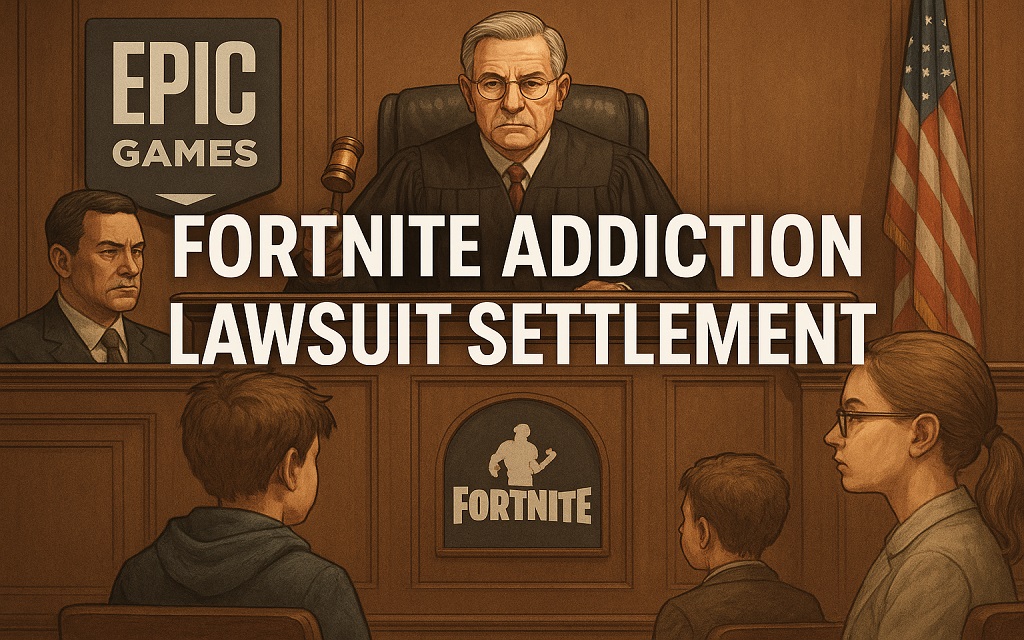You should understand why this case (Fortnite addiction lawsuit settlement) began. Parents in Canada filed a class-action lawsuit against Epic Games. The claim stated that Fortnite was designed to be addictive. Children spent excessive hours on the game. They skipped meals and school. Some developed behavioral issues.
Epic Games faced intense criticism. The core issue centered on game mechanics. Legal teams argued that the developers used tactics similar to those in gambling platforms. These included variable reward systems and unpredictable loot boxes.
In 2022, a Quebec judge approved the class-action motion. Knowing that this step allowed the case to move forward officially is essential. The decision relied on expert findings. Health professionals linked video game addiction to mental and physical harm.
What is the History of Fortnite Addiction lawsuits?
Fortnite gained popularity shortly after its 2017 release due to its stunning visuals and engaging gameplay. But there were concerns that it might promote addictive trends, especially in children and teenagers. Parents and guardians have connected overgaming to neglect of responsibilities, social estrangement, and financial difficulty from in-game expenditures.
Why Did the Court Accept the Case?
Legal experts highlighted several reasons. The court found potential evidence that Epic Games created Fortnite to manipulate user behavior. Lawyers presented neurological data, showing how the game triggered dopamine reactions in children.
The ruling also emphasized the lack of warnings. You might not know that Fortnite did not include clear alerts about excessive usage. This failure supported claims of negligence.
According to CBC News, the judge ruled that the claim was “not frivolous.” This gave the green light for the lawsuit to proceed under Canadian law. Courts considered it similar to tobacco and junk food cases.
What Were the Key Allegations?
You should look at the specific legal claims. Each supported the broader accusation of unethical game design.
- Use of behavioral psychology to increase engagement
- Failure to provide addiction warnings
- Encouragement of in-game spending by minors
- Disregard for age-appropriate design standards
- Psychological manipulation through reward loops
Legal teams argued that minors were especially vulnerable. You can compare this to how companies once targeted sugary drinks to children.
In one example, a 13-year-old played for nearly 8 hours daily. His grades dropped, and his social behavior changed. Parents reported signs similar to substance addiction.
What is the Current Status of the Fortnite Addiction Lawsuit settlement?
You should note that no global settlement has been finalized yet. However, some families received private settlements based on case severity. These followed a tiered structure.
- Tier 1 cases resulted in up to $2 million payouts
- Tier 2 cases received $60,000 to $300,000
- Tier 3 cases ranged between $5,000 and $50,000
Each payout reflected documented psychological harm. Victims had to provide medical records, screen time logs, and behavioral assessments.
Legal analysts say a broader settlement may arrive soon. Epic Games faces growing public pressure, and regulatory authorities in other countries have started their own investigations.
How Does Fortnite Affect the Brain?
It is essential to know how Fortnite works neurologically. Studies by Stanford and McGill found that similar games trigger dopamine release. Children repeat behavior to chase rewards, creating a habit loop.
Experts call it “digital dependency.” Your child might feel anxious or restless without the game. Researchers link long-term exposure to sleep issues, memory problems, and reduced academic performance.
A study from the University of Montreal found that boys aged 12 to 16 who played for 6+ hours daily had lower test scores and lower emotional regulation. This supported many of the lawsuit’s claims.
What Role Does Game Design Play in Addiction?
You should examine the structure of the game itself. Fortnite uses features such as:
- Daily rewards
- Limited-time events
- Randomized loot drops
- Peer-to-peer ranking systems
- Bright, immersive visual environments
Each element increases screen time, and children often feel pressured to return. The system preys on FOMO (fear of missing out).
Designers often consult behavioral experts and test which features maximize retention. Critics say this blurs ethical lines, as addiction becomes a metric for success.
Is Epic Games Responsible for Player Harm?
Courts must determine how much blame developers share. Similar lawsuits in the tech space, such as Facebook and TikTok, have also faced claims of user harm.
Legal precedent continues to evolve. It is important to remember that this case involves minors. Courts often apply higher standards when companies target children.
The core argument lies in intentionality. If Epic Games knew the game could cause harm and chose to hide the risk, they may face significant penalties.
What Are the Legal Consequences for Epic Games?
You should expect several outcomes if the plaintiffs win. Financial compensation is the first. However, Epic Games may also face:
- Mandated warnings before game startup
- Parental control enforcement
- Refunds for unauthorized in-game purchases
- Design limitations on reward systems
Law360 says legal experts believe this case could reshape the gaming industry. Consumer protection standards may expand to include addictive digital behavior.
What Can Parents Do Right Now?
You can take several steps if you suspect addiction. Experts recommend:
- Monitoring game usage daily
- Setting fixed screen time limits
- Discussing emotional triggers with children
- Using professional help if symptoms worsen
The Canadian Paediatric Society encourages family-based tech rules. These reduce conflict and help children understand boundaries.
Digital addiction clinics have emerged in many cities. Some insurers now cover therapy for game addiction.
What Are the Global Implications?
Regulators worldwide are now reviewing similar complaints. France, the UK, and Australia have launched probes into digital design ethics. Expect tighter regulations in the coming years.
In 2024, lawmakers introduced a “cool-down” law in South Korea. This law restricts the amount of time a child can spend on a game in one sitting.
Epic Games may need to revise Fortnite globally. The lawsuit has sparked a debate about ethics in entertainment software.
How Does the Case Affect Other Game Developers?
Game studios watch the case closely. You might see changes across popular platforms. Developers may:
- Remove randomized in-game purchases
- Increase parental control features
- Add mental health warnings
- Redesign reward systems to reduce dependency
The financial stakes are high. According to Statista, the global gaming market will surpass $240 billion by 2026. If addiction lawsuits increase, profit margins could shrink.
What Does the Future Hold for Fortnite?
Epic Games will likely update Fortnite in response. You can expect:
- More visible health and safety tools
- Time limits on younger accounts
- Opt-in systems for purchases
- Partnership with mental health groups
As pressure builds, the company may launch educational campaigns. These could help rebuild public trust.
Players may also demand more transparency. If addiction risks remain hidden, the backlash will grow stronger.
Conclusion
You should stay informed as the lawsuit evolves. The Fortnite addiction lawsuit settlement has changed how courts view digital responsibility. It marks a shift toward user protection, especially for minors.
Epic Games now faces legal, social, and ethical challenges. If courts rule against them, the gaming industry could change permanently. Developers must prioritize health just as much as profit.
Parents, educators, and regulators will play a key role. You can help shape safer gaming by supporting transparency and accountability.
Must Read: What Is Unclaimed Money in Class Action Settlements?




